This post may contain affiliate links.
If you would like to make a fabric face mask, but don’t have a sewing machine, here are 5 ways to make a no-sew face mask with materials you can find at home (such as bandanas and hair ties).
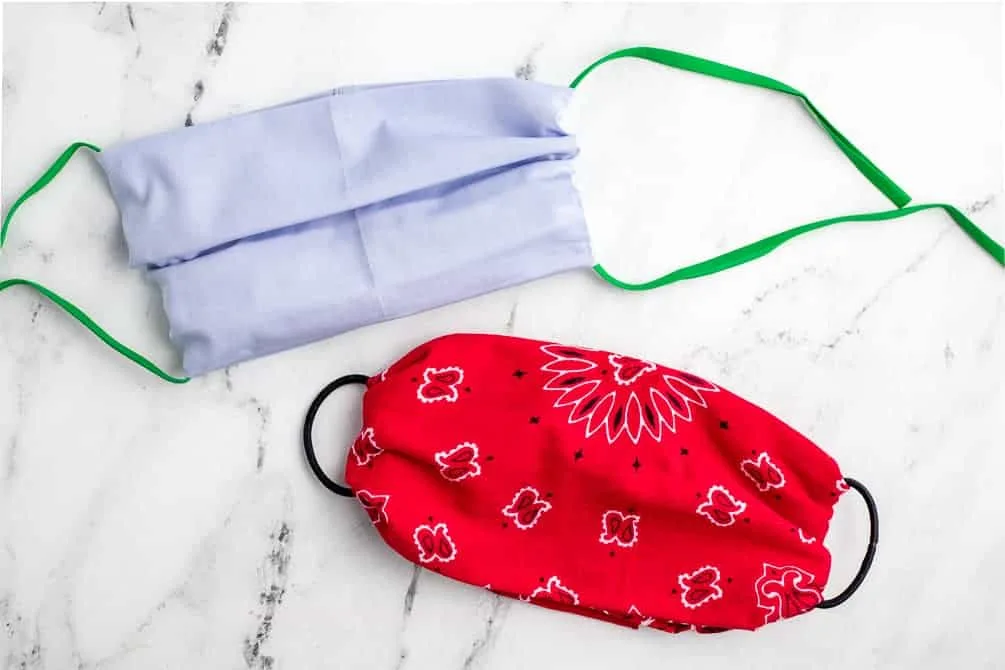
The CDC now recommends wearing cloth face coverings in public settings such as the grocery store. Using fabric face masks will help “slow the spread” in communities, and reserve medical-grade surgical masks and N95 respirators for healthcare workers and other medical first responders.
Now that the CDC has officially recommended the use of face masks in public, you may be wondering how to make a face mask at home.
Many face mask tutorials require a sewing machine — or a significant amount of patience with a needle and thread. But, this post will show you how to make a no-sew face mask at home, regardless of your sewing ability.
Important to Remember
A DIY face mask is not a replacement for a surgical mask or N-95 respirator. Rather, these masks are meant to help protect other people when you must go out in public.
Be sure to practice good hygiene and proper mask-wearing procedure. Be careful not to touch your eyes, nose, and mouth when removing your face covering and wash hands immediately after removing.
In addition, masks are not a replacement for social distancing. You should still be practicing 6-feet social distancing and frequently washing your hands for 20 seconds.
What is the Best Fabric for Homemade Face Masks?
Researchers at Cambridge University found that cotton T-shirts and cotton pillowcases are the best at-home materials for making DIY face masks, due to their ability to capture small particles yet remain breathable.
A Wake Forest study found that most effective masks were constructed of two layers of heavyweight “quilters cotton” with a thread count of at least 180.
When you are looking for fabric, try to find cotton fabric with a tight weave. Choose something with a high thread count — like a high-quality pillowcase or a re-purposed dress shirt.
5 Ways to Make No-Sew Masks
- With a Bandana and Hair Ties (or rubber bands)
- With a Bandana and Fabric Strips
- With a Woven Shirt Fabric Strips
- With Fabric Ties and Safety Pins
- With a T-Shirt
Mask designs are based on the CDC designs available on their website.
1. How to Make Face Mask with a Bandana and Hair Ties
One of the simplest and quickest ways to make a no-sew face mask is with a bandana (handkerchief or large cloth napkin) and two hair ties. If you have those materials at home, you can make a simple cloth face-covering in about a minute.

First, lay the handkerchief, bandana, or piece of fabric flat. Fold the top and bottom inward to meet in the middle. Then, fold the bandana in half again. There will be four layers of fabric.

Next, use two hair ties to create ear loops. Slip one hair tie over each of the ends. Slide the hair ties a few inches toward the middle of the folded bandana.
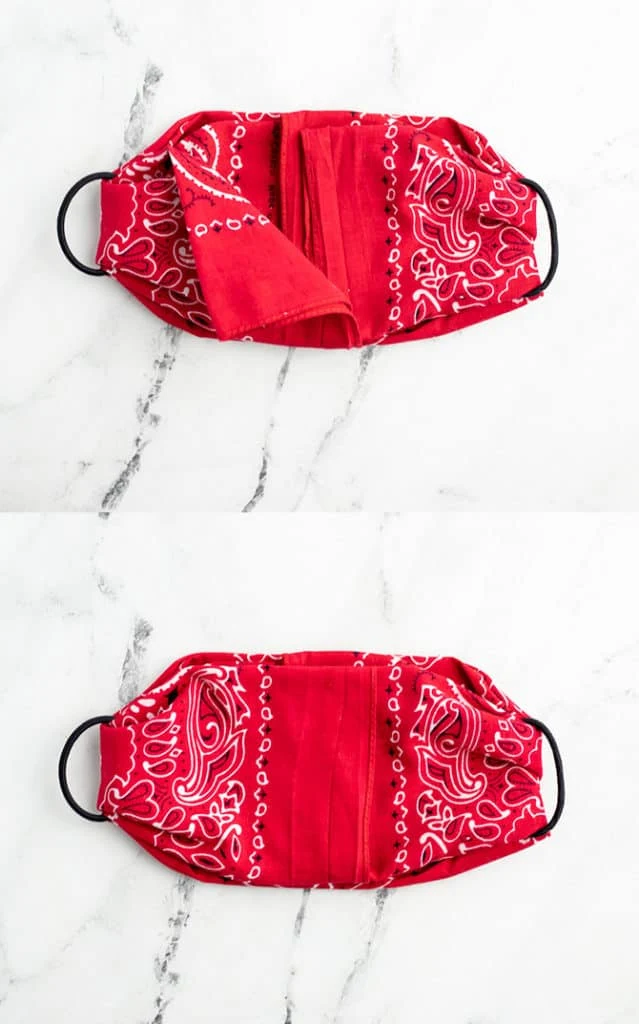
Then, fold the ends of the bandana in to meet in the middle. You want the ends to overlap slightly, so you can tuck one end into the other. This will help keep the ends secure.
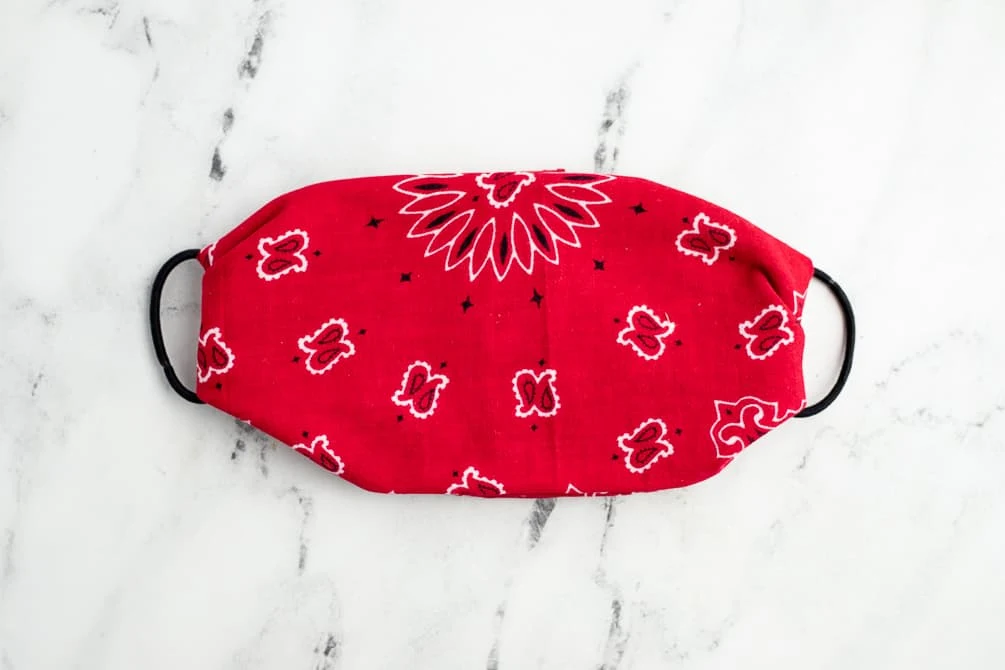
Wear the mask with the smooth side out and the ends against your face.
If the mask feels too tight around your ears, then you can adjust the position of the hair ties to make it wider.
Remember to wash the bandana after each use, or if it becomes moist during use.
Using Rubber Bands Instead of Hair Ties
If you don’t have hair ties — or find them uncomfortable around your ears — then you can substitute simple rubber bands. Fold the bandana in the same way, but use rubber bands instead of hair elastics.
2. Using Fabric Strips Instead of Hair Ties
If you would prefer to tie the mask around the back of the head, instead of behind the ears, then you can secure the mask with fabric ties.
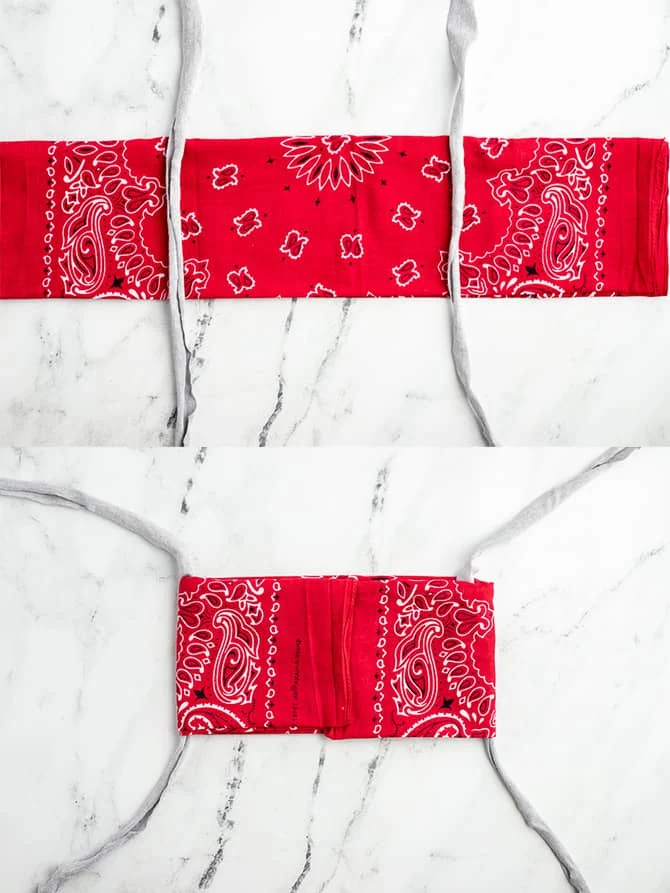
To make the strips, I cut two 1″-wide, 18″-long strips from a t-shirt. Lay the strips down in the same place you would have put the hair ties, and fold the bandana the same way as before.
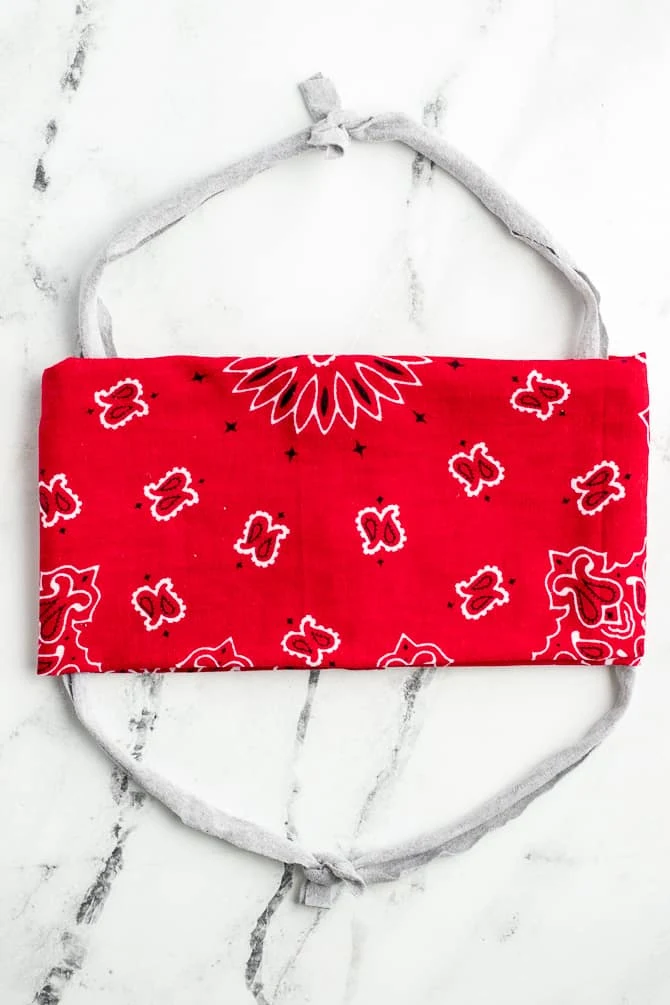
Wear the mask by tying the fabric strips behind your head and neck.
3. How to Make a Mask from a Woven Shirt
Another way to make a no-sew mask is with the sleeve cut from a (too-big, no longer worn) dress shirt.
For this mask, I used a button-up dress shirt made from a very tightly woven broadcloth fabric. I cut a section from the sleeve that measured approximately 8″ by 9″.

Fold each of the cut edges in toward the middle, about 3/4″, and press with an iron. If you have fabric glue, you can use a small amount to secure these folds.

Then, add fabric strips, bias binding, or other straps. Place them through the opening, and tie them behind the head and neck to wear the mask.

4. Using Safety Pins and Fabric Strips
Perhaps you prefer to use 4 fabric ties on your mask, one on each corner. In this case, you can use a safety pin to attach long fabric strips to your mask.
Use four small safety pins to attach the fabric strips to the sides of the mask.
The fabric strips will tie around the back of the head and neck. Many people find this is more comfortable to wear for extended amounts of time.
5. How to Make a Face Mask with a T-shirt
If you have an old T-shirt, then you can re-purpose it into a face mask.

Starting at a folded edge, cut this shape out of a t-shirt. The two strap pieces should measure about 12″ long by 1″ wide, and the rectangle on the folded edge should measure 4″ wide by 14″ tall. Once it is unfolded, the center rectangle should measure 8″ by 14″.

Lay out the cut piece, and fold the top half down over the bottom half. (This will give you two layers of fabric on the main part of the mask.) Once you’ve made this fold, the four ties will be at the four corners.

To wear the mask, tie the straps behind the head and behind the neck. You can positions both of the straps behind the head to adjust the fit.
Free Pattern to Sew a Pleated Fabric Face Mask
If you would prefer to sew a fabric face mask, I have another post with a free pattern and a step-by-step video. The pattern includes instructions for elastic ear loops or fabric ties. And, it has instructions to include a filter pocket. You can view that pattern here: How to Sew a Fabric Face Mask


How to Make A No-Sew Face Mask
How to make a no-sew fabric face mask from household materials, no sewing machine required.
Materials
- Bandana, handkerchief, or tightly woven cotton fabric about 18"-20" square.
- Two hair elastics, rubber bands, or strips of cotton fabric
Tools
- Scissors
- Optional: fabric glue
Instructions
Instructions are given for the most basic version of this no-sew mask. Please see all of the variations explained in the article above for more information.
- Lay the handkerchief, bandana, or piece of fabric flat. Fold the top and bottom inward to meet in the middle. Then, fold the bandana in half again. There will be four layers of fabric.
- Use two hair ties to create ear loops. Slip one hair tie over each of the ends. Slide the hair ties a few inches toward the middle of the folded bandana.
- Fold the ends of the bandana in to meet in the middle. You want the ends to overlap slightly, so you can tuck one end into the other. This will help keep the ends secure.
- Wear the mask with the smooth side out and the ends against your face.
Notes
If the mask feels too tight around your ears, then you can adjust the position of the hair ties to make it wider.
Remember to wash the bandana after each use, or if it becomes moist during use.

Sarah Stearns has helped millions of makers find their next craft project with free patterns and step-by-step tutorials on her blog, sarahmaker.com. Read more.
With over a decade of experience in knitting and crochet, she has been featured in prominent publications like The New York Times, Scientific American, Good Housekeeping, Vox, Apartment Therapy, and Lifehacker.


Rithvi Bawankule
Thursday 15th of October 2020
Wow! This is great. Thanks. Nice DIY idea. Useful.
Jimmy
Friday 28th of August 2020
So useful to me. I did try it for my family already! Thank you so much for this post!
Rithvi Bawankule
Thursday 15th of October 2020
Ya it's really useful I also tried it.
Must Your Face Mask Be A Hazard to Wildlife? – What Can YOU Do?
Tuesday 25th of August 2020
[…] No sew masks are also possible (see https://sarahmaker.com/how-to-make-a-no-sew-face-mask-with-at-home-materials/). Alternatively, we can buy cloth masks; there are many available in shops and for ordering […]
Margie
Saturday 22nd of August 2020
I am unable to print the pattern for the face mask.
Sarah
Saturday 22nd of August 2020
Hi, Search for the large blue print button at the bottom of the page.
Mask Wearing Tips for Kids with Sensory Issues
Tuesday 18th of August 2020
[…] If your child is old enough, you can even let them help make their own mask. There are many patterns for no-sew masks available online. Being part of the creation can make them feel more a part of this […]